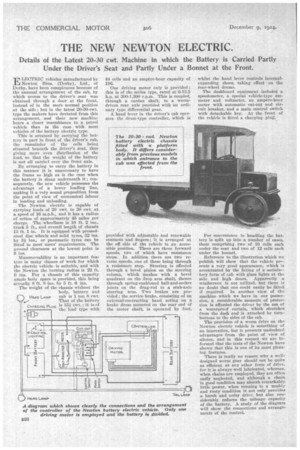THE NEW NEWTON ELECTRIC.
Page 10

If you've noticed an error in this article please click here to report it so we can fix it.
Details of the Latest 20-30 cwt. Machine in which the Battery is Carried Partly Under the Driver's Seat and Partly Under a Bonnet at the Front.
ELECTRIC vehicles manufactured by Newton Bros. (Derby), Ltd„ of Derby, have been conspicuous because of the unusual arrangement of the cab, by which access to the driver's seat was obtained through a door at the front, instead of in the more normal position at the side ; but in the latest 20-30-cwt. type the makers have deviated from this arrangement, and their new machine bears a closer resemblance to a petrol vehicle than is the case with most vehicles of the battery electric type.
This is attained by carrying the battery in part in front of the driver's cab, the remainder of ' the cells being situated beneath the driver's seat, thus giving more even distribution of the load, so that the weight of the battery is not all carried over the front axle.
By arranging to carry the battery in this manner it is unnecessary to have the frame so high as is the case when the battery is slung underneath it ; consequently, the new vehicle possesses the advantage of a lower loading line. making it a very sound proposition from the point of view of economical labour in loading and unloading.
The Newton electric is capable of carrying loads of 20 cwt. to 30 cwt. at a speed of 16 m.p.h., and it has a radius of action of approximately 45 miles per charge. The wheelbase is 10 ft. 2 ins., track 5 ft., and overall length of chassis 13 ft. 1 in. It is equipped with pressedsteel disc wheels and solid tyres, 32 ins. by 31 ins., or pneumatic tyres can be fitted to meet users' requirements. The ground clearance at the lowest point is 0 ins.
Manmwrability is an important feature in many classes of work for which the electric vehicle is suitable, and with the Newton the turning radius is 22 ft. 0 ins. For a chassis of this capacity ample body space is provided, this being actually 8 ft. 8 ins. by 5 ft. 6 ins.
The weight of the chassis without the body, battery and cab is 1 ton 8 cwt. That of the battery is 151 cwt.; it is of the lead type with HCHARGING PLUG HEAD LAMP
44 cells and an ampere-hour capacity of 196.
One driving motor only is provided ; this is of the series type, rated at 6-13.5 h.p. at 300-1,300 r.p.m. This is coupled, through a cardan shaft, to a wormdriven rear axle nrovided with an ordinary type differential gear.
A hand lever in the driver's cab operates the drum-type controller, which is provided with adjustable and renewable contacts and fingers; it is arranged at the off side of the vehicle in an accessible position. There are three forward speeds, two of which have resistance stops. In addition there are two reverse speeds, one of these being through a resistance stop. Steering is effected through a bevel pinion on the steering column, which meshes with a bevel quadrant on the drop arm shaft, thence through spring-cushioned ball-and-socket joints on the drag-rod to a stub-axle steering arm. Two brakes are provided; the service brake, consisting of an external-contracting band acting on a brake drum mounted on the rear end of the motor shaft, is operated by foot, whilst the hand lever controls internalexpanding shoes, taking effect on the rear-wheel drums.
The dashboard equipment' includes a speedometer, a special vehicle-type ammeter and voltmeter, an ampere-hour meter with automatic cut-out and circuit breaker, and a main control switch with detachable key. At the front of the vehicle is fitted a charging plug.
For convenience in handling the battery is split up into a number of cases, these comprising two of 10 cells each under the seat and two of 12 cells each under the bonnet.
Reference to the illustration which we publish will show that the vehicle presents a very good appearance, which is accentuated by the fitting of a satisfactory form of cab with glass lights at the side and high doors. Apparently a windscreen is not utilized, but there is no doubt that one could easily be fitted if required. In another view of the machine which we have in our possession, a considerable measure of protection is afforded the driver by the use of a waterproof curtain, which stretches from the dash and is attached by turnbuttons to the sides of the cab.
The provision of a worm drive on the Newton electric vehicle is something of an innovation, but it presents undoubted advantages from the point of view of silence, and in this respect we are informed that the tests of the Newton have shown that this is one of its most pleasing features.
There is really no reason why a welldesigned worm gear should not be quite as efficient as any other form of drive, for it is always well lubricated, whereas, when chains are employed, they are often sadly neglected, aud although a chain in good condition may absorb remarkably little power, when running in a muddy and rusty condition it not only provides a harsh and noisy drive, but also considerably reduces the mileage capacity of the battery. A study of the diagram will show the connections and arrangements of the control.






























